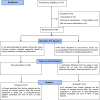A randomized controlled trial comparing different sites of high-velocity low amplitude thrust on sensorimotor integration parameters
- PMID: 38216596
- PMCID: PMC10786886
- DOI: 10.1038/s41598-024-51201-9
A randomized controlled trial comparing different sites of high-velocity low amplitude thrust on sensorimotor integration parameters
Abstract
Increasing evidence suggests that a high-velocity, low-amplitude (HVLA) thrust directed at a dysfunctional vertebral segment in people with subclinical spinal pain alters various neurophysiological measures, including somatosensory evoked potentials (SEPs). We hypothesized that an HVLA thrust applied to a clinician chosen vertebral segment based on clinical indicators of vertebral dysfunction, in short, segment considered as "relevant" would significantly reduce the N30 amplitude compared to an HVLA thrust applied to a predetermined vertebral segment not based on clinical indicators of vertebral dysfunction or segment considered as "non-relevant". In this double-blinded, active-controlled, parallel-design study, 96 adults with recurrent mild neck pain, ache, or stiffness were randomly allocated to receiving a single thrust directed at either a segment considered as "relevant" or a segment considered as "non-relevant" in their upper cervical spine. SEPs of median nerve stimulation were recorded before and immediately after a single HVLA application delivered using an adjusting instrument (Activator). A linear mixed model was used to assess changes in the N30 amplitude. A significant interaction between the site of thrust delivery and session was found (F1,840 = 9.89, p < 0.002). Pairwise comparisons showed a significant immediate decrease in the N30 complex amplitude after the application of HVLA thrust to a segment considered "relevant" (- 16.76 ± 28.32%, p = 0.005). In contrast, no significant change was observed in the group that received HVLA thrust over a segment considered "non-relevant" (p = 0.757). Cervical HVLA thrust applied to the segment considered as "relevant" altered sensorimotor parameters, while cervical HVLA thrust over the segment considered as "non-relevant" did not. This finding supports the hypothesis that spinal site targeting of HVLA interventions is important when measuring neurophysiological responses. Further studies are needed to explore the potential clinical relevance of these findings.
© 2024. The Author(s).
Conflict of interest statement
The authors declare no competing interests.
Figures



Similar articles
-
Neuromuscular Response to High-Velocity, Low-Amplitude Spinal Manipulation-An Overview.Medicina (Kaunas). 2025 Jan 22;61(2):187. doi: 10.3390/medicina61020187. Medicina (Kaunas). 2025. PMID: 40005304 Free PMC article. Review.
-
Upper cervical and upper thoracic thrust manipulation versus nonthrust mobilization in patients with mechanical neck pain: a multicenter randomized clinical trial.J Orthop Sports Phys Ther. 2012 Jan;42(1):5-18. doi: 10.2519/jospt.2012.3894. Epub 2011 Sep 30. J Orthop Sports Phys Ther. 2012. PMID: 21979312 Clinical Trial.
-
A pilot randomized clinical trial on the relative effect of instrumental (MFMA) versus manual (HVLA) manipulation in the treatment of cervical spine dysfunction.J Manipulative Physiol Ther. 2001 May;24(4):260-71. doi: 10.1067/mmt.2001.114365. J Manipulative Physiol Ther. 2001. PMID: 11353937 Clinical Trial.
-
Effects of thrust amplitude and duration of high-velocity, low-amplitude spinal manipulation on lumbar muscle spindle responses to vertebral position and movement.J Manipulative Physiol Ther. 2013 Feb;36(2):68-77. doi: 10.1016/j.jmpt.2013.01.004. J Manipulative Physiol Ther. 2013. PMID: 23499141 Free PMC article.
-
The Potential Mechanisms of High-Velocity, Low-Amplitude, Controlled Vertebral Thrusts on Neuroimmune Function: A Narrative Review.Medicina (Kaunas). 2021 May 27;57(6):536. doi: 10.3390/medicina57060536. Medicina (Kaunas). 2021. PMID: 34071880 Free PMC article. Review.
Cited by
-
Vertebral Subluxation and Systems Biology: An Integrative Review Exploring the Salutogenic Influence of Chiropractic Care on the Neuroendocrine-Immune System.Cureus. 2024 Mar 15;16(3):e56223. doi: 10.7759/cureus.56223. eCollection 2024 Mar. Cureus. 2024. PMID: 38618450 Free PMC article. Review.
-
The cervico-ocular reflex changes following treatment in individuals with subclinical neck pain: a randomized control trial.Exp Brain Res. 2024 Nov;242(11):2531-2544. doi: 10.1007/s00221-024-06915-7. Epub 2024 Sep 11. Exp Brain Res. 2024. PMID: 39261352 Clinical Trial.
-
Neuromuscular Response to High-Velocity, Low-Amplitude Spinal Manipulation-An Overview.Medicina (Kaunas). 2025 Jan 22;61(2):187. doi: 10.3390/medicina61020187. Medicina (Kaunas). 2025. PMID: 40005304 Free PMC article. Review.
-
The Impact of a Single Hip Manipulation on Quadriceps Activity and Performance: A Randomized Study.Biomedicines. 2025 Apr 8;13(4):900. doi: 10.3390/biomedicines13040900. Biomedicines. 2025. PMID: 40299492 Free PMC article.
-
Tailored Rehabilitation Program and Dynamic Ultrasonography After Surgical Repair of Bilateral Simultaneous Quadriceps Tendon Rupture in a Patient Affected by Gout: A Case Report.Healthcare (Basel). 2025 Jul 26;13(15):1830. doi: 10.3390/healthcare13151830. Healthcare (Basel). 2025. PMID: 40805863 Free PMC article.
References
-
- Cooperstein, R., Haneline, M. & Young, M. In Association of Chriopractic Colleges Educational Conference - Research Agenda Conference (ACC-RAC) (The Journal of Chiropractic Education, Vol. 24(1), 88, Las Vegas, Nevada, United States, 2010).
Publication types
MeSH terms
Grants and funding
LinkOut - more resources
Full Text Sources

